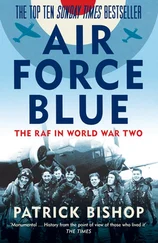“No noise, and no smoking cigarettes,” Paul said. “We’ll take care of him.”
We’ll take care of him? Clarence was horrified. He had hardly used the gun in daylight and now Paul wanted him to fire in pitch-darkness, at what? A sound? An enemy he couldn’t see?
He wished he could return to being a loader. A loader never saw much. Never did much. On a tank crew, the loader was pretty much just along for the ride. That was the good life. A gentle giant, Clarence simply wanted to slip through the war without killing anyone or getting killed himself.
No time for that. The German tank crew had likely realized their mistake by now.
“Gunner, ready?”
Panicked, Clarence turned and tugged on Paul’s pant leg.
Paul sank into the turret, exasperated. Clarence rattled off his doubts. What if he missed? What if he got a deflection and hit their own guys?
Paul’s voice calmed Clarence: “Somebody has to take the shot.”
As if the Germans had been listening, they suddenly cut their power. The hot engine hissed, then went silent.
Clarence felt a wave of relief. It was a reprieve. Paul must have been biting his lip in anger, because he said nothing at first. Finally, he informed the crew that now they would have to wait to fire at first light.
Clarence’s relief faded. His indecision had cost them whatever advantage they’d had. And against a German tank, they’d need every advantage they could get, especially if they were facing a Panther, the tank of nightmares. Some GIs called it “the Pride of the Wehrmacht,” and rumor had it that a Panther could shoot through one Sherman and into a second, and its frontal armor was supposedly impervious.
That July, the U.S. Army had placed several captured Panthers in a field in Normandy and blasted away at them with the same 75mm gun as in Clarence’s Sherman. The enemy tanks proved vulnerable from the flanks and rear, but not the front. Not a single shot managed to penetrate the Panther’s frontal armor, from any distance.
Clarence checked his luminescent watch, knowing the Germans were probably doing the same. The countdown had begun. Someone was going to die.
—
The loader fell asleep over the gun breech.
Three A.M. became four A.M.
Clarence and Paul passed a canteen of cold coffee back and forth. They had always joked that they were a family locked in a sardine can. And like a family, they didn’t always see eye to eye. Unlike Paul, who was always running off to help someone outside the tank, all Clarence cared about was his family on the inside—him and his crew.
This had been his way since childhood.
Growing up in industrial Lehighton, Pennsylvania, Clarence lived in a row house by the river, with walls so flimsy he could hear the neighbors. His parents were usually out working to keep the family afloat. His father did manual labor for the Civilian Conservation Corps and his mother was a housekeeper.
With the family’s survival at stake, Clarence was determined to contribute. When other kids played sports or did homework, twelve-year-old Clarence stacked a ballpark vendor’s box with candy bars and went selling door-to-door throughout Lehighton. Just a boy, he had vowed: I’ve got to take care of my family because no one is going to take care of us.
Clarence checked his periscope. To the east, a faint tinge of purple colored the horizon.
He kept his eyes glued to the glass until a blocky shape appeared about fifty yards away.
“I see it,” he whispered.
Paul rose to his hatch and saw it too. It looked like a rise of rock, highest at the midpoint. Clarence turned handwheels to fine-tune his aim.
Paul urged him to hurry. If they could see the enemy, the enemy could see them.
Clarence settled the reticle, as the gun sight’s crosshairs were known, on the “rock” at center mass and reported that he was ready. His boot hovered over the trigger, a button on the footrest.
“Fire,” Paul said.
Clarence’s foot stamped down.
Outside, a massive flash leapt from the Sherman’s barrel, momentarily illuminating the tanks—an olive-drab American and a sandy-yellow German—both facing the same direction.
Sparks burst from the darkness and a sound like an anvil strike pierced the countryside. Inside the turret, without the fan operating, smoke hung thick in the air. Clarence’s ears throbbed and his eyes stung, but he kept them pressed to his sight.
The loader chambered a new shell. Clarence again hovered his foot over the trigger.
“Nothing’s moving,” Paul said from above. A broadside at this range? It was undoubtedly a kill shot.
The intercom came alive with voices of relief, and Clarence moved his foot away from the trigger.
Paul radioed the platoon; the job was done.
Through his periscope, Clarence watched the sky warm beneath the dark clouds, revealing the boxy armor and the 11-foot, 8-inch long gun of a Panzer IV tank.
Known by the Americans as the Mark IV, the design was old, in service since 1938, and it had been the enemy’s most prevalent tank until that August, when the Panther began taking over. But even though it was no longer the mainstay, the Mark IV was still lethal. Its 75mm gun packed 25 percent more punch than Clarence’s.
More light revealed the tank’s dark green-and-brown swirls of camouflage and the German cross on the flank. Clarence had nearly placed his shot right on it.
“Think they’re in there?” One of the crewmen posed the question, seeing that the Mark IV’s hatch covers hadn’t budged.
Clarence envisioned a tank full of moaning, bleeding men and hoped the crew had slipped out in the night. He had no love for the Germans, but he hated the idea of killing any human being. He wasn’t about to look inside his first tank kill. A shell can ricochet like a supersonic pinball within the tight quarters, and he’d seen maintenance guys go inside to clean and come out crying after discovering brains on the ceiling.
“I’ll go.” Paul unplugged his helmet.
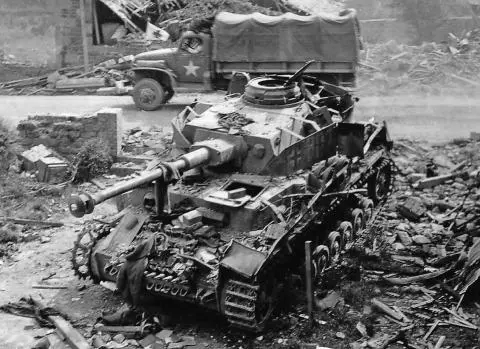
Panzer IV
Clarence tried to dissuade him. It wasn’t worth looking inside and getting his head blown off by a German.
Paul brushed away the concerns and radioed the platoon to hold their fire.
Through his periscope, Clarence watched Paul climb the Mark IV’s hull and creep toward the turret with his Thompson at the ready. With one hand steadying his gun, Paul opened the commander’s hatch and aimed the Thompson inside.
Nothing happened.
He leaned forward and took a long look, then shouldered his gun.
Paul sealed the hatch shut.
That same morning, September 3, 1944
Mons, Belgium
After the tense standoff of the previous night, the tanks were on the move.
Traveling solo or in pairs with the rising sun at their backs, multiple companies of Shermans flooded across the Mons countryside to extend the division’s reach, pressing the enemy into an ever-tightening cordon.
Every country lane, every farmer’s path, had to be roadblocked, which meant that Easy Company, too, would operate piecemeal today, and its crews would do their fighting alone.
With his goggles lowered, Paul rode head and shoulders above his open hatch, his jacket flapping in the wind. Thirty-three tons of tank churned beneath him, going about 20 miles per hour, following the road uphill between foggy fields.
The machine seemed alive. Everything vibrated: helmets and musette bags hung from the turret, a .30-caliber machine gun on a mount, spare tracks and wheels tied down wherever they would fit. The tank cleared its throat with each gear change. At the heart of its power was a 9-cylinder radial engine that had to be cranked awake by hand if it sat overnight.
Читать дальше
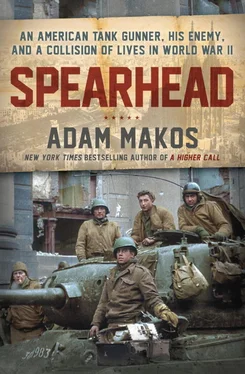






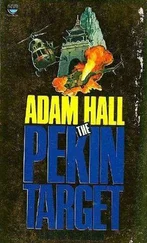

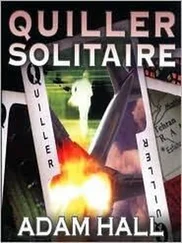
![Adam Turvi - Возвращение [СИ]](/books/422738/adam-turvi-vozvrachenie-si-thumb.webp)

